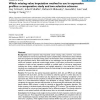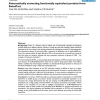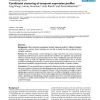BMCBI
2008
13 years 11 months ago
2008
Background: Gene expression data frequently contain missing values, however, most downstream analyses for microarray experiments require complete data. In the literature many meth...
BMCBI
2008
13 years 11 months ago
2008
Background: The previous studies of genome-wide expression patterns show that a certain percentage of genes are cell cycle regulated. The expression data has been analyzed in a nu...
BMCBI
2008
13 years 11 months ago
2008
Background: There is a frequent need to obtain sets of functionally equivalent homologous proteins (FEPs) from different species. While it is usually the case that orthology impli...
BMCBI
2008
13 years 11 months ago
2008
Background: Pseudogenes, nonfunctional copies of genes, evolve fast due the lack of evolutionary pressures and thus appear in several different forms. PseudoGeneQuest is an online...
BMCBI
2008
13 years 11 months ago
2008
Background: Over 60% of protein-coding genes in vertebrates express mRNAs that undergo alternative splicing. The resulting collection of transcript isoforms poses significant chal...
BMCBI
2008
2008
Modifying the DPClus algorithm for identifying protein complexes based on new topological structures
13 years 11 months ago
Background: Identification of protein complexes is crucial for understanding principles of cellular organization and functions. As the size of protein-protein interaction set incr...
BMCBI
2008
13 years 11 months ago
2008
Background: Cancer diagnosis and clinical outcome prediction are among the most important emerging applications of gene expression microarray technology with several molecular sig...
BMCBI
2008
13 years 11 months ago
2008
Background: Protein-protein interactions are ubiquitous and essential for all cellular processes. High-resolution X-ray crystallographic structures of protein complexes can reveal...
BMCBI
2008
13 years 11 months ago
2008
BMCBI
2008
13 years 11 months ago
2008
Background: The rapid annotation of genes on a genome-wide scale is now possible for several organisms using high-throughput RNA interference assays to knock down the expression o...



